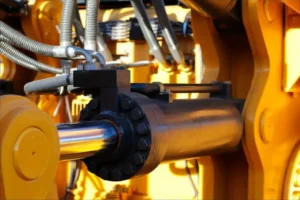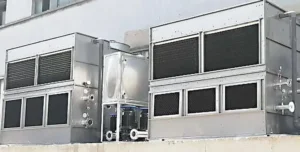เมื่อพูดถึงการละลายผงอลูมิเนียมสำหรับการหล่อหรือการผลิตโลหะผสม, the choice of furnace plays a crucial role in ensuring efficiency, คุณภาพ, and cost-effectiveness. Among the various options available, the medium-frequency electric furnace (MF furnace) and gas furnaces are two common choices. While both have their advantages, medium-frequency electric furnaces are increasingly preferred over gas furnaces for melting aluminum powder. Below, we explore the key reasons why.

Precise Temperature Control
Medium-frequency electric furnaces offer superior temperature control compared to gas furnaces. In a gas furnace, controlling the temperature can be challenging due to the fluctuation in the flame and combustion gases, which can cause uneven heat distribution. ในทางตรงกันข้าม, the MF furnace utilizes electromagnetic induction to heat the aluminum powder directly, allowing for precise and uniform temperature control.
This is especially critical when melting aluminum powder, as precise temperature control is essential to avoid oxidation or degradation of the material. Aluminum powder is highly sensitive to temperature fluctuations, and a stable heat environment helps in maintaining the integrity of the powder throughout the melting process.
Faster Melting Times
Medium-frequency electric furnaces are more efficient at heating metal than gas furnaces, thanks to the direct method of heating through electromagnetic induction. This allows the aluminum powder to melt faster, reducing the overall cycle time and increasing production efficiency. ในทางตรงกันข้าม, gas furnaces rely on combustion, which takes longer to reach the necessary temperatures and can lead to higher heat losses in the process.
The speed of melting in an MF furnace can significantly enhance productivity, making it an ideal choice for industries where time is a critical factor.
ประสิทธิภาพการใช้พลังงาน
Electric furnaces, especially medium-frequency ones, are highly energy-efficient. Since the aluminum powder is heated directly by induction, much of the electrical energy is converted into heat, reducing wasted energy. Gas furnaces, ในทางกลับกัน, often suffer from higher energy losses due to heat escaping from the furnace walls or inefficiencies in the combustion process.
By using a medium-frequency electric furnace, manufacturers can significantly lower energy consumption, which leads to reduced operational costs and a more sustainable production process.
Cleaner and Safer Operation
One of the major advantages of electric furnaces over gas furnaces is the cleaner and safer operation. Gas furnaces rely on combustion, which produces emissions, including carbon dioxide, nitrogen oxides, and potentially harmful gases. These emissions must be carefully managed to ensure a safe working environment and compliance with environmental regulations.
On the other hand, medium-frequency electric furnaces produce no direct emissions during the melting process. The absence of combustion also eliminates the need for gas storage, piping, and related safety concerns, reducing the risk of leaks, explosions, and other hazards associated with gas-based systems.
Reduced Oxidation of Aluminum Powder
Aluminum is highly susceptible to oxidation when exposed to high temperatures in the presence of oxygen. In a gas furnace, the combustion process creates a large amount of oxygen, which can react with the aluminum and lead to oxidation, causing loss of metal quality and yield.
ในทางตรงกันข้าม, a medium-frequency electric furnace operates in a more controlled and oxygen-reduced environment, which minimizes the chances of oxidation. This results in higher-quality aluminum with less contamination, making it ideal for applications where purity is crucial.
Lower Maintenance and Longer Lifespan
Electric furnaces generally require less maintenance than gas furnaces. Gas furnaces involve more complex mechanical systems, including burners, gas lines, and exhaust systems, all of which require regular maintenance to ensure safe and efficient operation. These components also wear out over time, requiring costly repairs or replacements.
Medium-frequency electric furnaces, by contrast, have fewer moving parts and rely on simpler induction coils and electrical systems. ผลที่ตามมา, they tend to have lower maintenance costs and a longer operational lifespan, making them a more cost-effective choice in the long run.
ข้อพิจารณาด้านสิ่งแวดล้อม
With increasing focus on sustainability and reducing the carbon footprint of industrial operations, the environmental impact of melting processes is becoming more important. Medium-frequency electric furnaces are considered environmentally friendly compared to gas furnaces because they do not produce harmful emissions during operation.
นอกจากนี้, the ability to integrate electric furnaces with renewable energy sources, such as solar or wind power, further enhances their environmental credentials. This is particularly important for companies looking to meet stricter environmental regulations or improve their sustainability practices.
บทสรุป
สรุป, while both medium-frequency electric furnaces and gas furnaces have their own set of advantages, the benefits of using an MF furnace for melting aluminum powder are clear. From precise temperature control and faster melting times to energy efficiency, ความปลอดภัย, and reduced oxidation, the medium-frequency electric furnace is the superior choice for industries seeking higher-quality products, lower operating costs, and a cleaner, more sustainable melting process.
As the demand for high-performance aluminum products continues to grow, transitioning to a medium-frequency electric furnace offers a competitive edge in terms of both operational efficiency and product quality.







